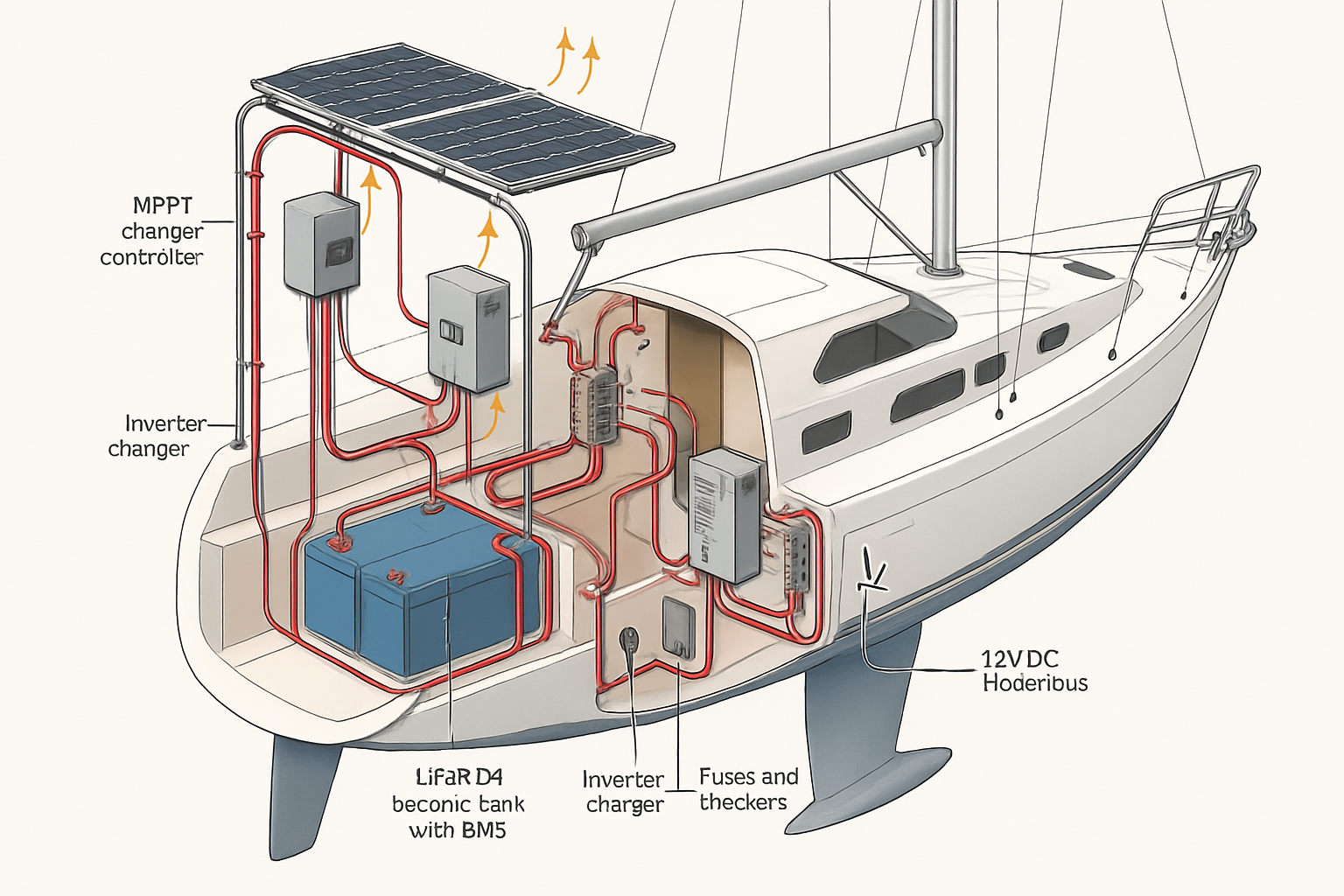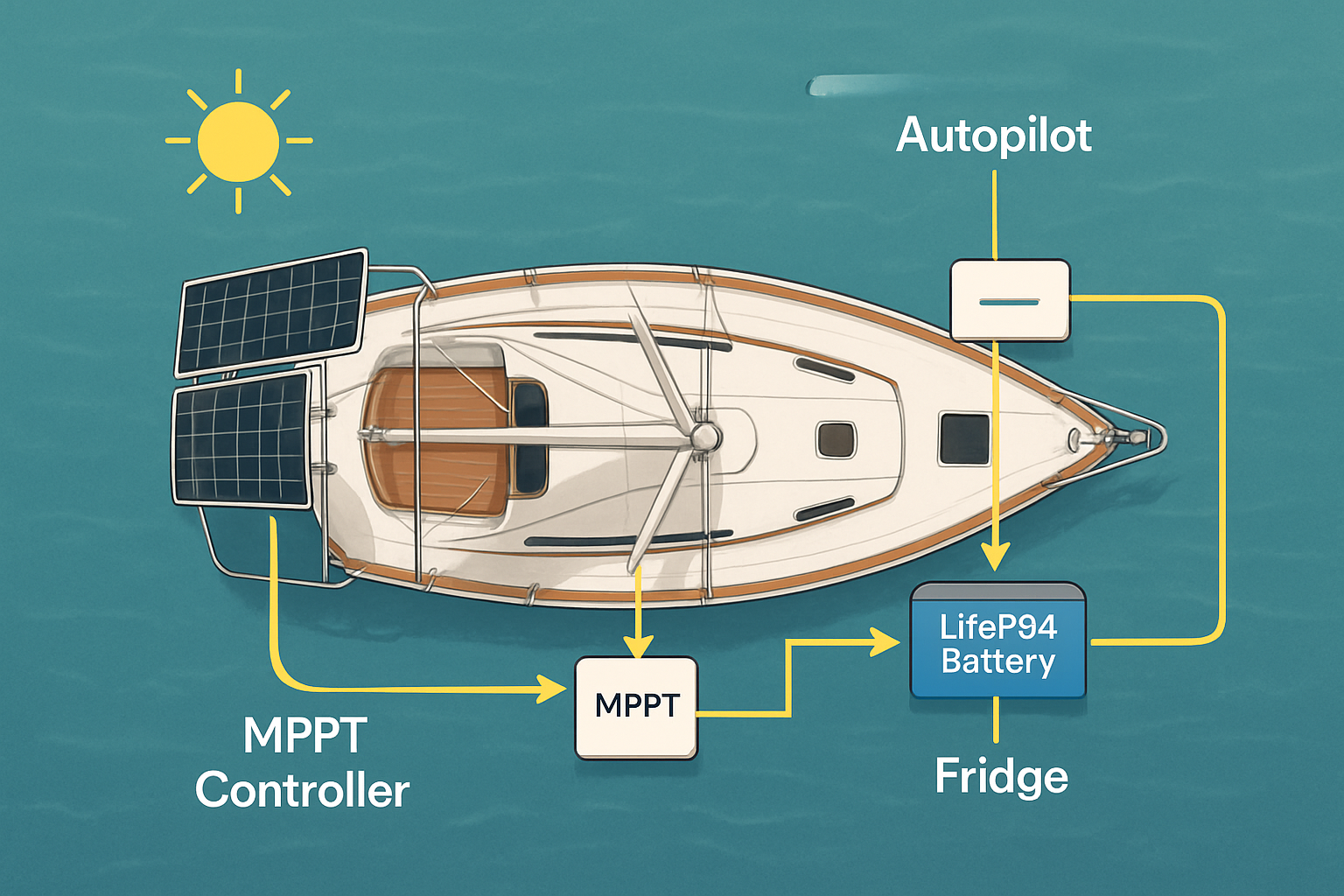The hum of a generator or the constant need to run your engine for power can disrupt the tranquility of being on the water. For many boat owners, the goal is independence—freedom from the shore power pedestal and the noise of fossil fuels. Marine solar power systems offer a silent, reliable, and increasingly efficient way to achieve this energy independence. This guide provides a detailed look at designing and implementing a solar energy system for your vessel, covering everything from core components to system sizing and real-world applications.
The Core Components of a Boat Solar System
A well-functioning marine solar installation is more than just a panel. It's a balanced system where each component works together to capture, store, and deliver power efficiently. Understanding these parts is the first step toward building a reliable off-grid setup.

Solar Panels: Capturing the Sun's Energy
Photovoltaic (PV) panels are the foundation of your system. They convert sunlight directly into DC electrical energy. In the marine environment, panels must withstand harsh conditions like saltwater spray, UV exposure, and physical stress. Most modern panels use highly efficient monocrystalline cells, which offer better performance in a smaller footprint compared to older polycrystalline technology. A key decision you'll face is choosing between two main formats. You can learn more about the specific tradeoffs in the article Flexible vs Rigid Marine Solar Panels: Which Suits Your Boat?
- Rigid Panels: These are typically more durable and offer a lower cost per watt. Their aluminum frames and tempered glass surfaces provide excellent protection for the solar cells, making them a long-lasting choice for mounting on arches, hardtops, or custom frames.
- Flexible Panels: These lightweight panels are ideal for mounting on curved surfaces or directly on the deck. Their low profile reduces windage, but they can be more susceptible to heat buildup and physical damage if not installed correctly.
The Battery Bank: Your Onboard Power Reserve
The battery bank is the heart of your off-grid system. It stores the energy generated by your solar panels for use at night or on cloudy days. While traditional lead-acid batteries have been used for years, Lithium Iron Phosphate (LiFePO4) technology presents significant advantages for marine applications. As specialists in LiFePO4 battery manufacturing, we have seen firsthand how this chemistry transforms onboard power systems.
LiFePO4 batteries offer a greater depth of discharge (DoD), meaning you can use more of their stored capacity without causing damage. They also provide thousands of charge cycles, lasting much longer than their lead-acid counterparts. Furthermore, they are significantly lighter, a critical consideration for any vessel. A high-performance, reliable LiFePO4 battery bank ensures you have a deep and dependable power reserve.
Charge Controllers and Inverters: Managing the Flow of Power
Simply connecting a solar panel to a battery is a recipe for damage. You need components to manage the energy flow. A solar charge controller regulates the voltage and current from the panels to prevent overcharging the batteries. For marine systems, a Maximum Power Point Tracking (MPPT) controller is the superior choice. It optimizes the output from the panels, especially in conditions of partial shading or variable sunlight, which are common on a boat. For a deeper analysis, see our review of MPPT Charge Controllers for Boats: Tested Picks and Tradeoffs.
While your panels and batteries operate on DC power, many onboard appliances like laptops, kitchen gadgets, or power tools require AC power. A solar inverter converts DC electricity from your batteries into usable AC electricity. Choosing a pure sine wave inverter is crucial for running sensitive electronics safely. Our line of solar inverters is designed to provide clean, stable AC power for all your needs. The question of Can Solar Really Run Boat Electronics? What Works and What Fails often comes down to having the right inverter.
Sizing Your Marine Solar System for True Off-Grid Boating
Proper system sizing is the most critical step. An undersized system leads to frustration and a constant lack of power, while an oversized one means unnecessary cost and weight. Sizing is a three-step process: calculating your needs, determining your solar array size, and specifying your battery bank capacity.
Step 1: Calculating Your Daily Energy Consumption
Before you can generate power, you must know how much you use. An energy audit involves listing every DC and AC electrical device on your boat, its power draw (in Amps or Watts), and the estimated number of hours you use it per day. Multiplying the power draw by the hours of use gives you the daily consumption for each device. Summing these figures provides your total daily energy requirement in Watt-hours (Wh). Be thorough, as underestimating your usage is one of the 7 Costly Marine Solar Mistakes That Drain Your Battery Bank.
Sample Daily Energy Audit
| Appliance | Power Draw (Watts) | Hours of Use / Day | Daily Consumption (Wh) |
|---|---|---|---|
| LED Cabin Lights (x4) | 20 W | 4 hrs | 80 Wh |
| Refrigerator (DC) | 60 W (30% duty cycle) | 24 hrs | 432 Wh |
| VHF Radio (standby) | 1 W | 24 hrs | 24 Wh |
| Autopilot | 36 W | 5 hrs | 180 Wh |
| Laptop Charging | 65 W | 2 hrs | 130 Wh |
| Total Daily Need | 846 Wh |
Step 2: Sizing Your Solar Array
Your solar array must be large enough to replenish your daily energy usage and account for system inefficiencies. The key variable here is "peak sun hours"—the average number of hours per day when the sun's intensity is sufficient for peak panel output. This varies by location and season. A conservative estimate for many cruising areas is 4 to 5 hours.
A simple formula is: Total Daily Wh / Peak Sun Hours = Required Solar Panel Wattage. For our 846 Wh example, with 4 peak sun hours, you would need approximately 212 Watts of solar panels (846 / 4). It is wise to add a 20-25% margin to account for factors like shading and cloudy weather. You can explore more about real-world output in Marine Solar Myths vs Reality: Output, Shading, and Corrosion.
Step 3: Sizing Your LiFePO4 Battery Bank
Your battery bank should be sized to cover your daily needs plus a reserve for days with no sun (autonomy). With LiFePO4 batteries, you can safely use 80-90% of the rated capacity. To calculate the required size in Amp-hours (Ah), use this formula: (Daily Wh × Days of Autonomy) / Battery Voltage. For a 12V system with a daily need of 846 Wh and a desire for 2 days of autonomy, the calculation would be (846 × 2) / 12 = 141 Ah. A 150 Ah or 200 Ah LiFePO4 battery would provide a solid reserve. For a complete walkthrough, consult our guide on How to Size Marine Solar and LiFePO4 for Reliable Boat Power.
Practical Applications and Real-World Use Cases
A properly installed marine photovoltaic system transforms the boating experience. It moves beyond just keeping the lights on to enabling a truly self-sufficient lifestyle on the water.
Powering Essential Electronics and Appliances
The primary benefit is reliably running your onboard systems without engine noise. This includes navigation instruments, communication gear, lighting, and refrigeration. With a robust solar setup and an integrated Energy Storage System (ESS), you can even power high-draw items like an autopilot or fridge without ever starting the engine. This is a core principle behind our off-grid solar solutions. An integrated ESS, which combines LiFePO4 batteries and a hybrid inverter, simplifies power management and ensures a seamless supply. Learn how to Stop Idling: Use Solar and ESS to Power Autopilot and Fridges.
From Weekenders to Full-Time Liveaboards
Marine solar power is scalable. A weekender might only need a 100-200W array to keep batteries topped off and run basic electronics. In this scenario, the Cost-Benefit Math: Solar vs Alternator for Weekender Boat Loads clearly favors solar for its silent, fuel-free operation. A full-time liveaboard, on the other hand, might install 800W or more to power a full suite of household appliances. As this Case Study: 400W Solar + ESS Keeps a Liveaboard Off-Grid shows, even a mid-sized system can provide complete energy independence.
The Future of Marine Photovoltaics
The technology continues to improve. According to data from agencies like the International Renewable Energy Agency (IRENA), PV module efficiency is rising while costs are falling. These trends are making solar power more accessible and effective for small craft than ever before. For more on this, see the Data Brief: IEA/IRENA Trends Shaping Marine PV for Small Craft.
Installation and System Integration
A great design can be undermined by a poor installation. In the marine environment, attention to detail is paramount to ensure safety, longevity, and performance.
Mounting and Wiring Best Practices
Securely mounting your panels is essential to withstand wind and waves. Wiring must be done with marine-grade, tinned-copper wire of the correct gauge to prevent voltage drop and corrosion. All connections should be sealed against moisture, and the system must be properly fused for protection. Following best practices for installation ensures a quiet, reliable, and vibration-proof system. For detailed techniques, review these 9 Wiring and Mounting Tips for Quiet, Vibration-Proof Boat Solar.
Building a Complete Blueprint
Bringing all the components together into a cohesive system is the final step. The panels, charge controller, battery bank, and inverter must be matched to work in harmony. This balanced approach is key to efficiency and reliability. Our integrated ESS solutions are designed to simplify this process, providing a pre-configured and tested core for your power system. For a holistic view, consider The Ultimate Marine Solar Blueprint: Panels, Inverters, LiFePO4.
Your Voyage to Energy Independence
Investing in a marine solar power system is an investment in freedom. It offers the quiet satisfaction of generating your own clean power, the reliability of a full battery bank, and the ability to stay longer in remote anchorages. By carefully calculating your needs and choosing high-quality components like LiFePO4 batteries and MPPT controllers, you can build a scalable and dependable energy solution that enhances every moment you spend on the water. This is the path to true energy independence at sea.
Disclaimer: This article is for informational purposes only and does not constitute professional engineering or financial advice. Consult with a qualified marine electrician for your specific installation needs.





Leave a comment
All comments are moderated before being published.
This site is protected by hCaptcha and the hCaptcha Privacy Policy and Terms of Service apply.